5.3 Adolescence

adolescence the transition period from childhood to adulthood, extending from puberty to independence.
5-12 How is adolescence defined, and how do physical changes affect developing teens?
Many psychologists once believed that childhood sets our traits. Today’s developmental psychologists see development as lifelong. As this life-span perspective emerged, psychologists began to look at how maturation and experience shape us not only in infancy and childhood, but also in adolescence and beyond. Adolescence—the years spent morphing from child to adult—starts with the physical beginnings of sexual maturity and ends with the social achievement of independent adult status (which means that in some cultures, where teens are self-supporting, adolescence hardly exists).
204
How will you look back on your life 10 years from now? Are you making choices that someday you will recollect with satisfaction?
In industrialized countries, what are the teen years like? In Leo Tolstoy’s Anna Karenina, the teen years were “that blissful time when childhood is just coming to an end, and out of that vast circle, happy and gay, a path takes shape.” But another teenager, Anne Frank, writing in her diary while hiding from the Nazis, described tumultuous teen emotions:
My treatment varies so much. One day Anne is so sensible and is allowed to know everything; and the next day I hear that Anne is just a silly little goat who doesn’t know anything at all and imagines that she’s learned a wonderful lot from books…. Oh, so many things bubble up inside me as I lie in bed, having to put up with people I’m fed up with, who always misinterpret my intentions.
G. Stanley Hall (1904), one of the first psychologists to describe adolescence, believed that this tension between biological maturity and social dependence creates a period of “storm and stress.” Indeed, after age 30, many who grow up in independence-fostering Western cultures look back on their teenage years as a time they would not want to relive, a time when their peers’ social approval was imperative, their sense of direction in life was in flux, and their feeling of alienation from their parents was deepest (Arnett, 1999; Macfarlane, 1964).
But for many, adolescence is a time of vitality without the cares of adulthood, a time of rewarding friendships, heightened idealism, and a growing sense of life’s exciting possibilities.
Physical Development
puberty the period of sexual maturation, during which a person becomes capable of reproducing.
Adolescence begins with puberty, the time when we mature sexually. Puberty follows a surge of hormones, which may intensify moods and which trigger the bodily changes discussed in Chapter 4.
Earlyversus late maturing. Just as in the earlier life stages, the sequence of physical changes in puberty (for example, breast buds and visible pubic hair before menarche—the first menstrual period) is far more predictable than their timing. Some girls start their growth spurt at 9, some boys as late as age 16. Though such variations have little effect on height at maturity, they may have psychological consequences. It is not only when we mature that counts, but how people react to our physical development.
For boys, early maturation has mixed effects. Boys who are stronger and more athletic during their early teen years tend to be more popular, self-assured, and independent, though also more at risk for alcohol use, delinquency, and premature sexual activity (Conley & Rudolph, 2009; Copeland et al., 2010; Lynne et al., 2007). For girls, early maturation can be a challenge (Mendle et al., 2007). If a young girl’s body and hormone-fed feelings are out of sync with her emotional maturity and her friends’ physical development and experiences, she may begin associating with older adolescents or may suffer teasing or sexual harassment (Ge & Natsuaki, 2009). She may also be somewhat more vulnerable to an anxiety disorder (Weingarden & Renshaw, 2012).
Girls in various countries are developing breasts and reaching puberty earlier today than in the past, a phenomenon variously attributed to increased body fat, increased hormone-mimicking chemicals in the diet, and increased stress related to family disruption (Biro et al., 2010, 2012; Ellis et al., 2012; Herman-Giddens, 2013). Researchers wonder: If early puberty is disadvantageous for girls, are today’s girls paying a price? Remember: Nature and nurture interact.
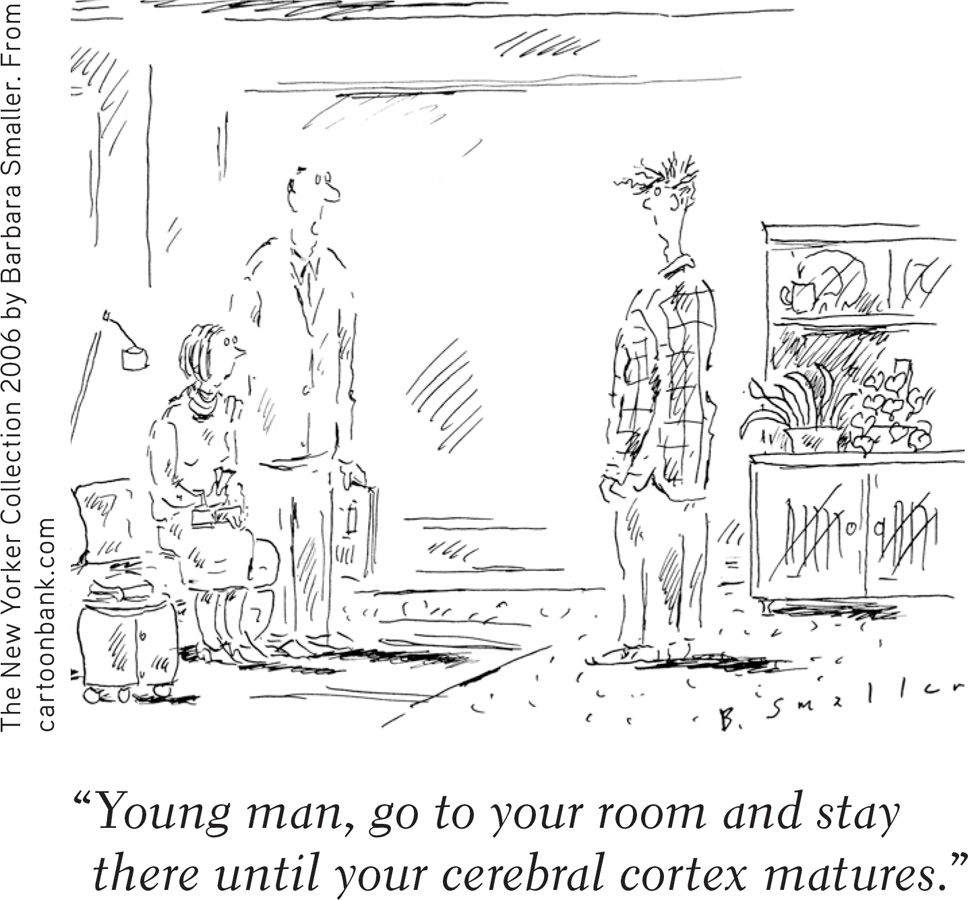
The teenage brain. An adolescent’s brain is also a work in progress. Until puberty, brain cells increase their connections, like trees growing more roots and branches. Then, during adolescence, comes a selective pruning of unused neurons and connections (Blakemore, 2008). What we don’t use, we lose. It’s rather like traffic engineers reducing congestion by eliminating certain streets and constructing new beltways that move traffic more efficiently.
205
Compared with adults, teens listen more to music and prefer more intense music (Bonneville-Roussy et al., 2013).
As teens mature, their frontal lobes also continue to develop. The growth of myelin, the fatty tissue that forms around axons and speeds neurotransmission, enables better communication with other brain regions (Kuhn, 2006; Silveri et al., 2006). These developments bring improved judgment, impulse control, and long-term planning.
Frontal lobe maturation nevertheless lags behind that of the emotional limbic system. Puberty’s hormonal surge and limbic system development help explain teens’ occasional impulsiveness, risky behaviors, and emotional storms—slamming doors and turning up the music (Casey et al., 2008, 2013). No wonder younger teens (whose unfinished frontal lobes aren’t yet fully equipped for making long-term plans and curbing impulses) may succumb to the tobacco corporations, which most adult smokers could tell them they will later regret. Teens actually don’t underestimate the risks of smoking—or fast driving or unprotected sex. They just, when reasoning from their gut, weigh the benefits more heavily (Reyna & Farley, 2006; Steinberg, 2007, 2010). Teens find rewards more exciting than adults do. So they seek thrills and rewards, without a fully developed brake pedal controlling their impulses (FIGURE 5.18).
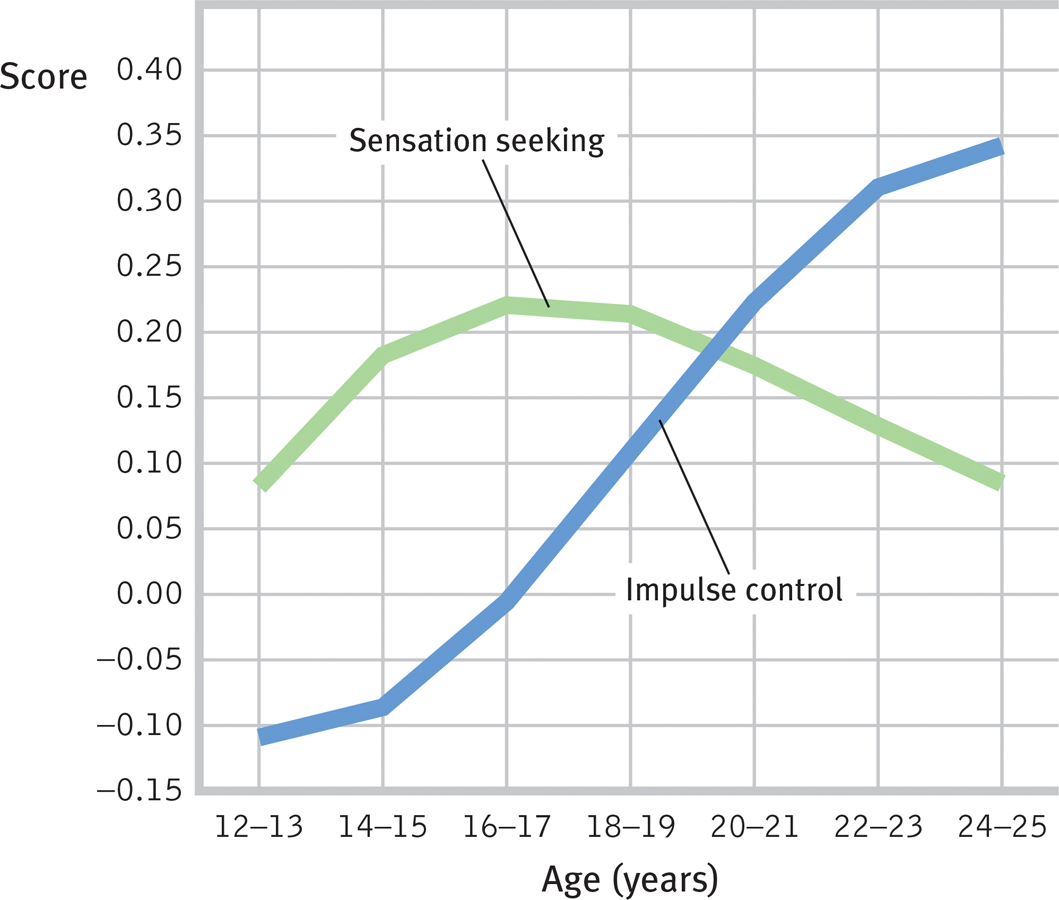
 Figure 5.18
Figure 5.18Impulse control lags reward seeking National surveys of more than 7000 American 12- to 24-year-olds reveal that sensation seeking peaks in the mid-teens, with impulse control developing more slowly as frontal lobes mature. (National Longitudinal Study of Youth and Children and Young Adults survey data presented by Steinberg, 2013.)
So, when Junior drives recklessly and academically self-destructs, should his parents reassure themselves that “he can’t help it; his frontal cortex isn’t yet fully grown”? They can at least take hope: Brain changes underlie teens’ new self-consciousness about what others are thinking and their valuing of risky rewards (Barkley-Levenson & Galván, 2014; Somerville et al., 2013). And the brain with which Junior begins his teens differs from the brain with which he will end his teens. Unless he slows his brain development with heavy drinking—leaving him prone to impulsivity and addiction—his frontal lobes will continue maturing until about age 25 (Beckman, 2004; Crews et al., 2007). They will also become better connected with the limbic system, enabling better emotion regulation (Steinberg, 2012).
In 2004, the American Psychological Association (APA) joined seven other medical and mental health associations in filing U.S. Supreme Court briefs, arguing against the death penalty for 16- and 17-year-olds. The briefs documented the teen brain’s immaturity “in areas that bear upon adolescent decision making.” Brain scans of young teens reveal that frontal lobe immaturity is most evident among juvenile offenders and drug users (Shannon et al., 2011; Whelan et al., 2012). Thus, teens are “less guilty by reason of adolescence,” suggested psychologist Laurence Steinberg and law professor Elizabeth Scott (2003; Steinberg et al., 2009). In 2005, by a 5-to-4 margin, the Court concurred, declaring juvenile death penalties unconstitutional. In 2012, the APA offered similar arguments against sentencing juveniles to life without parole (Banville, 2012; Steinberg, 2013). Once again, the court, by a narrow 5-to-4 vote, concurred.
Cognitive Development
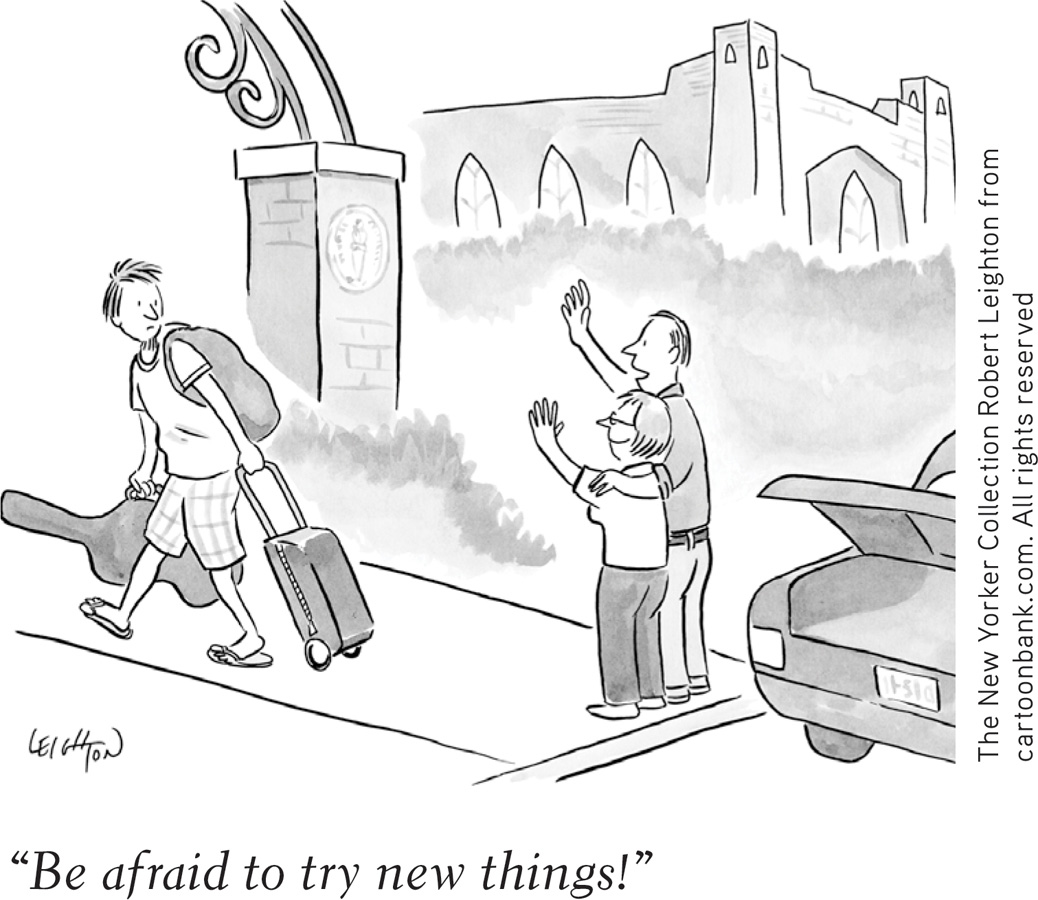
5-13 How did Piaget, Kohlberg, and later researchers describe adolescent cognitive and moral development?
“When the pilot told us to brace and grab our ankles, the first thing that went through my mind was that we must all look pretty stupid.”
Jeremiah Rawlings, age 12, after a 1989 DC-10 crash in Sioux City, Iowa
During the early teen years, reasoning is often self-focused. Adolescents may think their private experiences are unique, something parents just could not understand: “But, Mom, you don’t really know how it feels to be in love” (Elkind, 1978). Capable of thinking about their own thinking, and about other people’s thinking, they also begin imagining what others are thinking about them. (They might worry less if they understood their peers’ similar self-absorption.) Gradually, though, most begin to reason more abstractly.
206
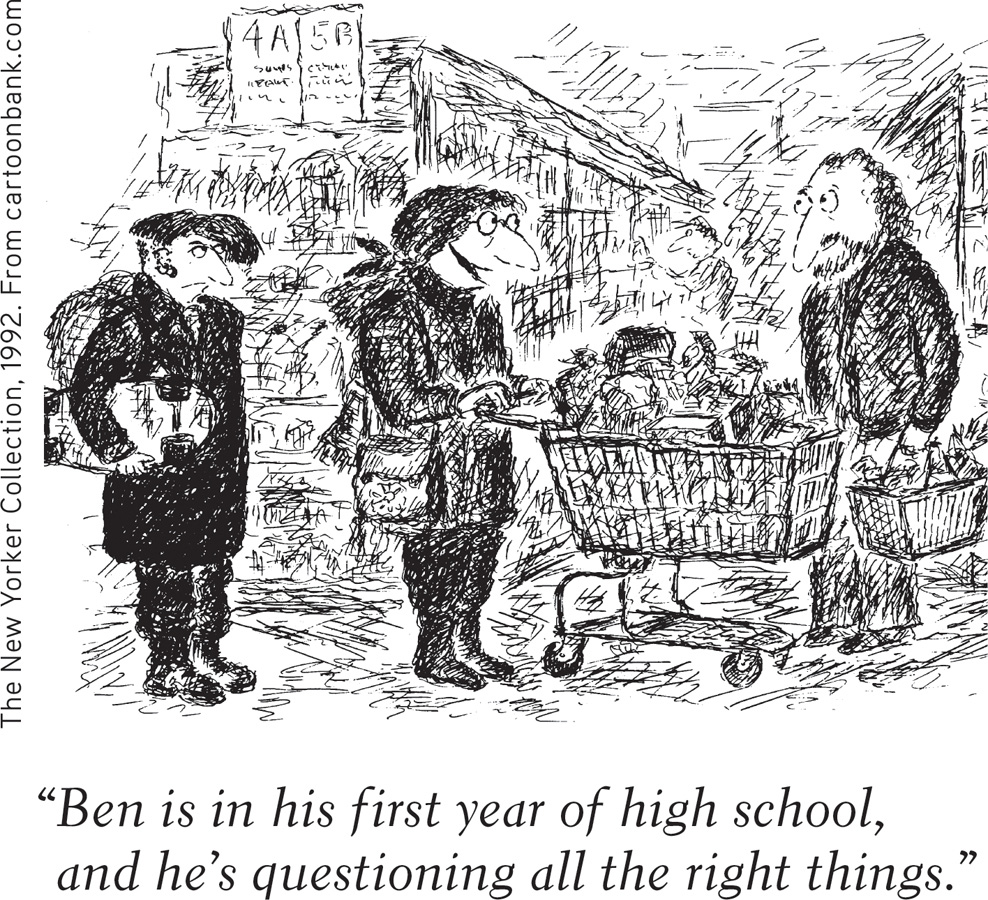
Developing Reasoning Power
When adolescents achieve the intellectual summit that Jean Piaget called formal operations, they apply their new abstract reasoning tools to the world around them. They may think about what is ideally possible and compare that with the imperfect reality of their society, their parents, and themselves. They may debate human nature, good and evil, truth and justice. Their sense of what’s fair changes from simple equality to equity—to what’s proportional to merit (Almås et al., 2010). Having left behind the concrete images of early childhood, they may now seek a deeper conception of God and existence (Boyatzis, 2012; Elkind, 1970). Reasoning hypothetically and deducing consequences also enables adolescents to detect inconsistencies and spot hypocrisy in others’ reasoning. This can lead to heated debates with parents and silent vows never to lose sight of their own ideals (Peterson et al., 1986).

Developing Morality
Two crucial tasks of childhood and adolescence are discerning right from wrong and developing character—the psychological muscles for controlling impulses. To be a moral person is to think morally and act accordingly. Jean Piaget and Lawrence Kohlberg proposed that moral reasoning guides moral actions. A newer view builds on psychology’s game-changing recognition that much of our functioning occurs not on the “high road” of deliberate, conscious thinking but on the “low road,” unconscious and automatic.
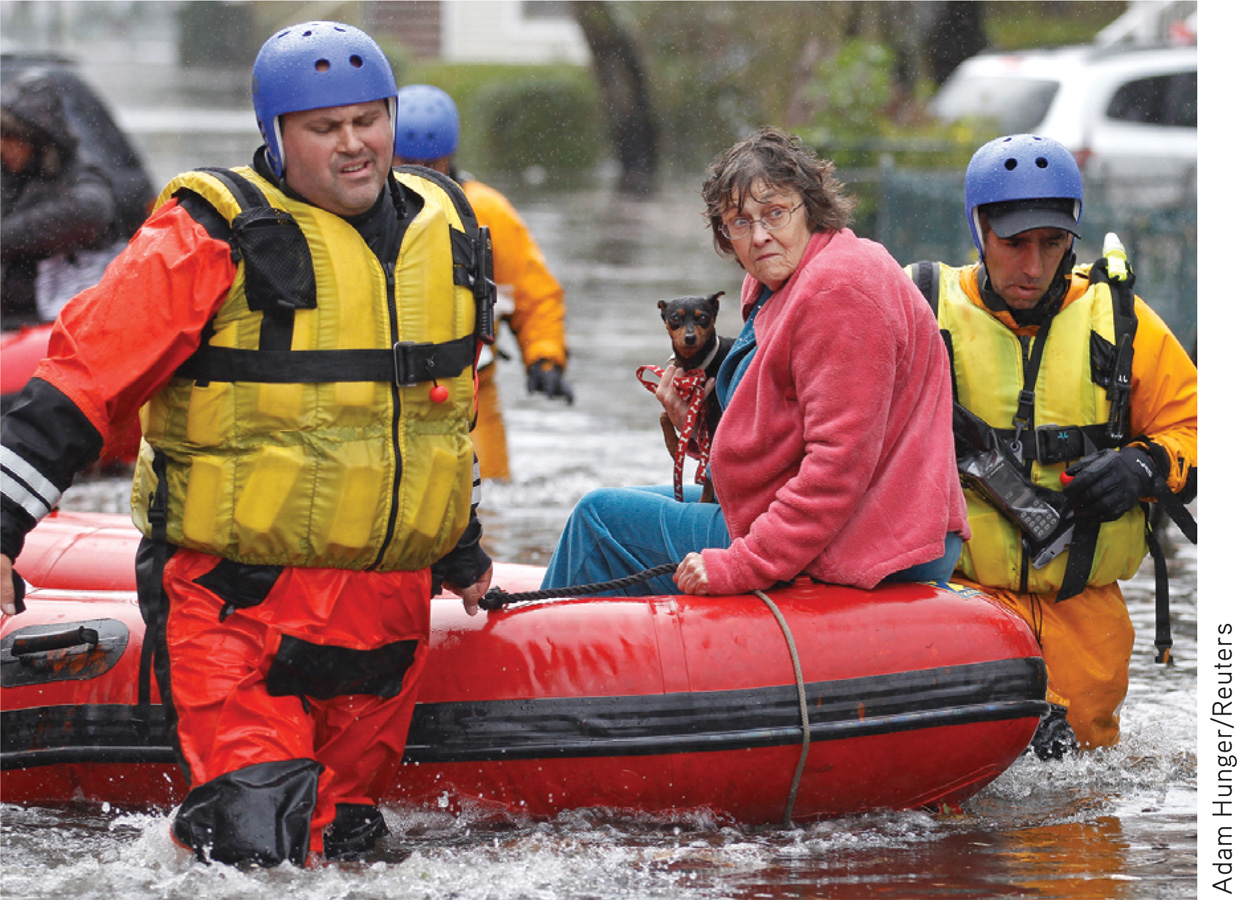
Moral Reasoning Piaget (1932) believed that children’s moral judgments build on their cognitive development. Agreeing with Piaget, Lawrence Kohlberg (1981, 1984) sought to describe the development of moral reasoning, the thinking that occurs as we consider right and wrong. Kohlberg posed moral dilemmas (for example, whether a person should steal medicine to save a loved one’s life) and asked children, adolescents, and adults whether the action was right or wrong. His analysis of their answers led him to propose three basic levels of moral thinking: preconventional, conventional, and postconventional (TABLE 5.3). Kohlberg claimed these levels form a moral ladder. As with all stage theories, the sequence is unvarying. We begin on the bottom rung. Preschoolers, typically identifying with their cultural group, conform to and enforce its moral norms (Schmidt & Tomasello, 2012). Later, we ascend to varying heights. Kohlberg’s critics have noted that his postconventional stage is culturally limited, appearing mostly among people who prize individualism (Eckensberger, 1994; Miller & Bersoff, 1995).

 Table 5.3
Table 5.3Kohlberg’s Levels of Moral Thinking
Moral Intuition Psychologist Jonathan Haidt (2002, 2012) believes that much of our morality is rooted in moral intuitions—“quick gut feelings, or affectively laden intuitions.” According to this intuitionist view, the mind makes moral judgments as it makes aesthetic judgments—quickly and automatically. We feel disgust when seeing people engaged in degrading or subhuman acts. Even a disgusting taste in the mouth heightens people’s disgust over various moral digressions (Eskine et al., 2011). We feel elevation—a tingly, warm, glowing feeling in the chest—when seeing people display exceptional generosity, compassion, or courage. These feelings in turn trigger moral reasoning, says Haidt.
207
One woman recalled driving through her snowy neighborhood with three young men as they passed “an elderly woman with a shovel in her driveway. I did not think much of it, when one of the guys in the back asked the driver to let him off there…. When I saw him jump out of the back seat and approach the lady, my mouth dropped in shock as I realized that he was offering to shovel her walk for her.” Witnessing this unexpected goodness triggered elevation: “I felt like jumping out of the car and hugging this guy. I felt like singing and running, or skipping and laughing. I felt like saying nice things about people” (Haidt, 2000).
“Could human morality really be run by the moral emotions,” Haidt wonders, “while moral reasoning struts about pretending to be in control?” Consider the desire to punish. Laboratory games reveal that the desire to punish wrongdoings is mostly driven not by reason (such as an objective calculation that punishment deters crime) but rather by emotional reactions, such as moral outrage (Darley, 2009). After the emotional fact, moral reasoning—our mind’s press secretary—aims to convince us and others of the logic of what we have intuitively felt.
This intuitionist perspective on morality finds support in a study of moral paradoxes. Imagine seeing a runaway trolley headed for five people. All will certainly be killed unless you throw a switch that diverts the trolley onto another track, where it will kill one person. Should you throw the switch? Most say Yes. Kill one, save five.
Now imagine the same dilemma, except that your opportunity to save the five requires you to push a large stranger onto the tracks, where he will die as his body stops the trolley. The logic is the same—kill one, save five?—but most say No. Seeking to understand why, a Princeton research team led by Joshua Greene (2001) used brain imaging to spy on people’s neural responses as they contemplated such dilemmas. Only when given the body-pushing type of moral dilemma did their brain’s emotion areas activate. Thus, our moral judgments provide another example of the two-track mind—of dual processing (Feinberg et al., 2012). Moral reasoning, centered in one brain area, says throw the switch. Our intuitive moral emotions, rooted in other brain areas, override reason when saying don’t push the man.
While the new research illustrates the many ways moral intuitions trump moral reasoning, other research reaffirms the importance of moral reasoning. The religious and moral reasoning of the Amish, for example, shapes their practices of forgiveness, communal life, and modesty (Narvaez, 2010). Joshua Greene (2010) likens our moral cognition to a camera. Usually, we rely on the automatic point-and-shoot. But sometimes we use reason to manually override the camera’s automatic impulse.
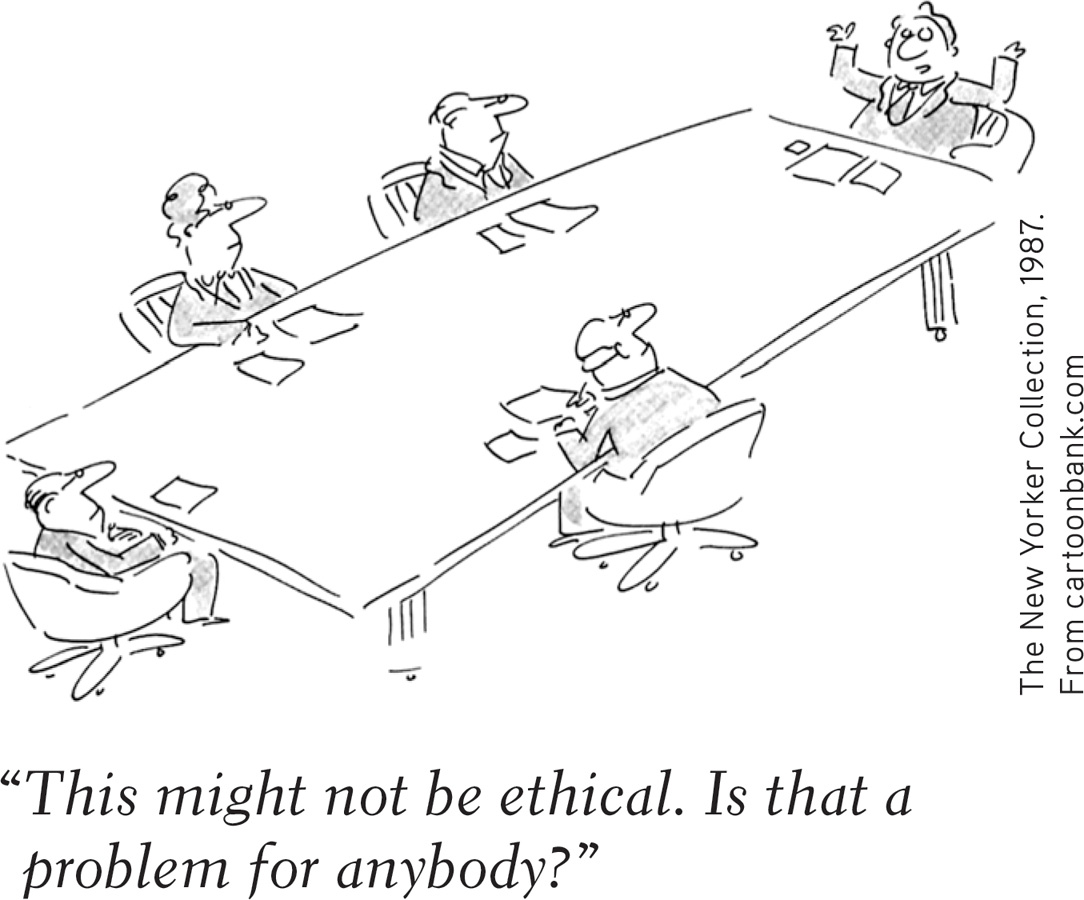
208
Moral Action Our moral thinking and feeling surely affect our moral talk. But sometimes talk is cheap and emotions are fleeting. Morality involves doing the right thing, and what we do also depends on social influences. As political theorist Hannah Arendt (1963) observed, many Nazi concentration camp guards during World War II were ordinary “moral” people who were corrupted by a powerfully evil situation.
Today’s character education programs tend to focus on the whole moral package— thinking, feeling, and doing the right thing. In service-learning programs, teens have tutored, cleaned up their neighborhoods, and assisted older adults. The result? The teens’ sense of competence and desire to serve has increased, and their school absenteeism and dropout rates have diminished (Andersen, 1998; Piliavin, 2003). Moral action feeds moral attitudes.
“It is a delightful harmony when doing and saying go together.”
Michel Eyquem de Montaigne (1533–1592)
A big part of moral development is the self-discipline needed to restrain one’s own impulses—to delay small gratifications now to enable bigger rewards later. In one of psychology’s best-known experiments, Walter Mischel (1988, 1989) gave Stanford nursery school 4-year-olds a choice between a marshmallow now, or two marshmallows when he returned a few minutes later. The children who had the willpower to delay gratification went on to have higher college completion rates and incomes, and less often suffered addiction problems. Moreover, when a sample of Mischel’s marshmallow alums were retested on a new willpower test 40 years later, their differences persisted (Casey et al., 2011).
Our capacity to delay gratification—to pass on small rewards now for bigger rewards later—is basic to our future academic, vocational, and social success. Teachers and parents rate children who delay gratification on a marshmallow-like test as more self-controlled (Duckworth et al., 2013). A preference for large-later rather than small-now rewards minimizes one’s risk of problem gambling, smoking, and delinquency (Callan et al., 2011; Ert et al., 2013; van Gelder et al., 2013). The moral of the story: Delaying gratification—living with one eye on the future—fosters flourishing.
RETRIEVAL PRACTICE
- According to Kohlberg, ______________ morality focuses on self-interest, ______________ morality focuses on self-defined ethical principles, and ______________ morality focuses on upholding laws and social rules.
preconventional; postconventional; conventional
Social Development
5-14 What are the social tasks and challenges of adolescence?
“Somewhere between the ages of 10 and 13 (depending on how hormone-enhanced their beef was), children entered adolescence, a.k.a. ‘the de-cutening.’”
Jon Stewart et al., Earth (The Book), 2010
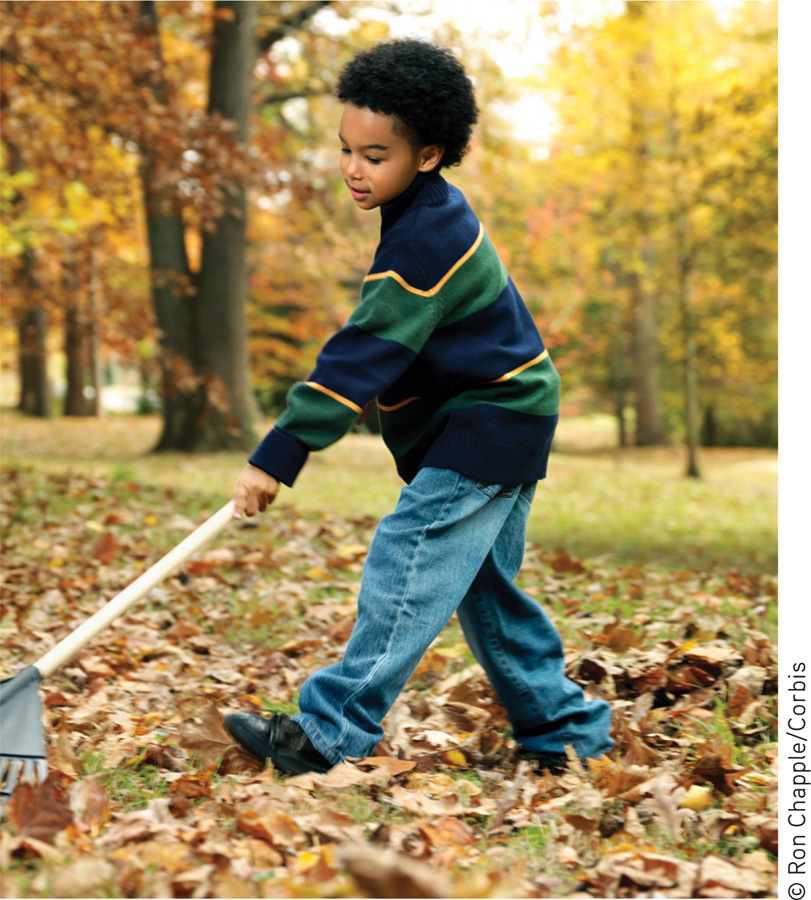

Theorist Erik Erikson (1963) contended that each stage of life has its own psychosocial task, a crisis that needs resolution. Young children wrestle with issues of trust, then autonomy (independence), then initiative. School-age children strive for competence, feeling able and productive. The adolescent’s task is to synthesize past, present, and future possibilities into a clearer sense of self (TABLE 5.4). Adolescents wonder, “Who am I as an individual? What do I want to do with my life? What values should I live by? What do I believe in?” Erikson called this quest the adolescent’s search for identity.

 Table 5.4
Table 5.4Erikson’s Stages of Psychosocial Development
As sometimes happens in psychology, Erikson’s interests were bred by his own life experience. As the son of a Jewish mother and a Danish Gentile father, Erikson was “doubly an outsider,” reported Morton Hunt (1993, p. 391). He was “scorned as a Jew in school but mocked as a Gentile in the synagogue because of his blond hair and blue eyes.” Such episodes fueled his interest in the adolescent struggle for identity.
209
Forming an Identity
“Self-consciousness, the recognition of a creature by itself as a ‘self,’ [cannot] exist except in contrast with an ‘other,’ a something which is not the self.”
C. S. Lewis, The Problem of Pain, 1940
identity our sense of self; according to Erikson, the adolescent’s task is to solidify a sense of self by testing and integrating various roles.
social identity the “we” aspect of our self-concept; the part of our answer to “Who am I?” that comes from our group memberships.
To refine their sense of identity, adolescents in individualist cultures usually try out different “selves” in different situations. They may act out one self at home, another with friends, and still another at school or online. If two situations overlap—as when a teenager brings friends home—the discomfort can be considerable. The teen asks, “Which self should I be? Which is the real me?” The resolution is a self-definition that unifies the various selves into a consistent and comfortable sense of who one is—an identity.

For both adolescents and adults, group identities are often formed by how we differ from those around us. When living in Britain, I [DM] become conscious of my Americanness. When spending time with my daughter in Africa, I become conscious of my minority White race. When surrounded by women, I am mindful of my gender identity. For international students, for those of a minority ethnic group or sexual orientation, or for people with a disability, a social identity often forms around their distinctiveness.
Erikson noticed that some adolescents forge their identity early, simply by adopting their parents’ values and expectations. (Traditional, less individualist cultures teach adolescents who they are, rather than encouraging them to decide on their own.) Other adolescents may adopt the identity of a particular peer group—jocks, preps, geeks, band kids, debaters.
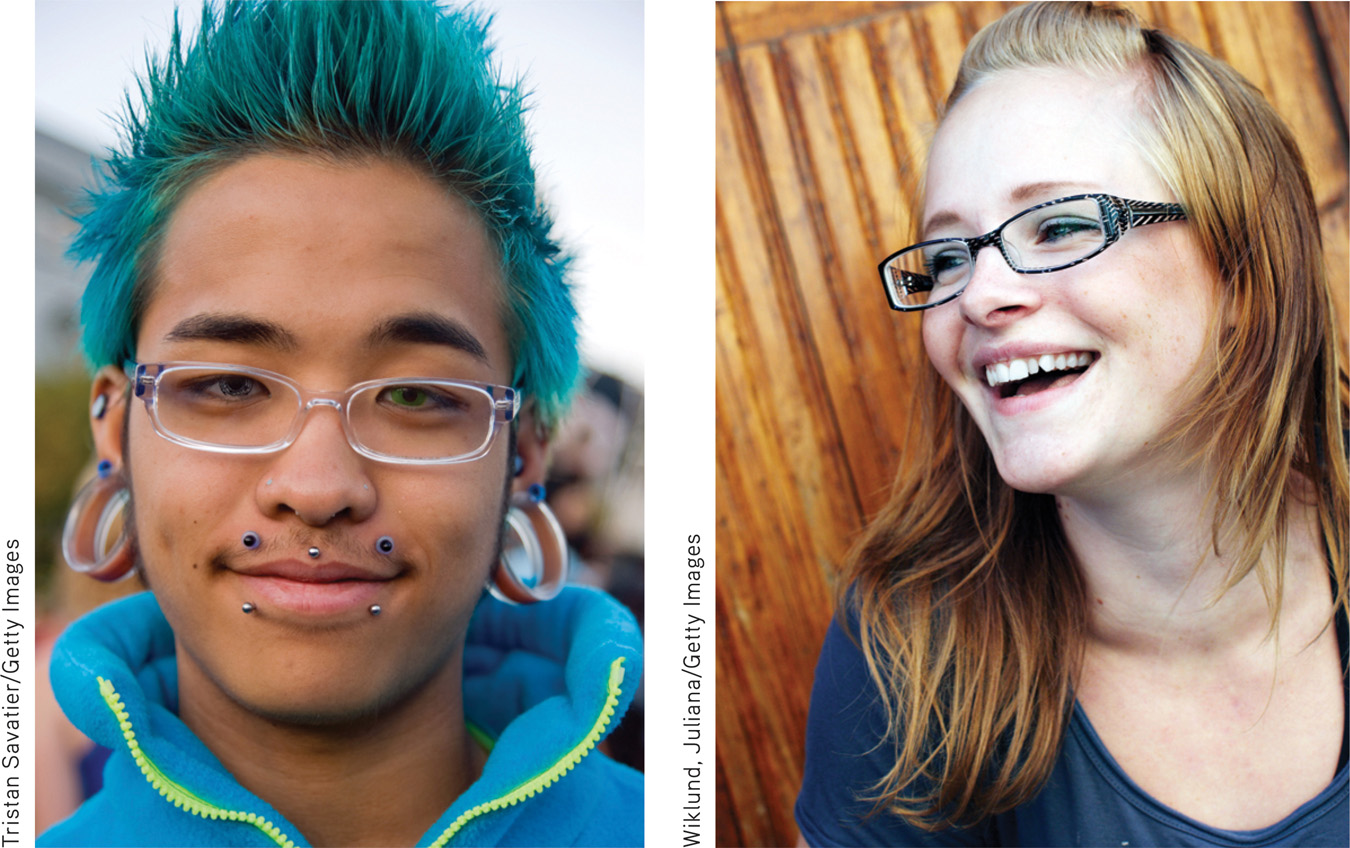
 For an interactive self-assessment of your own identity, see LaunchPad’s PsychSim 6: Who Am I?
For an interactive self-assessment of your own identity, see LaunchPad’s PsychSim 6: Who Am I?
Most young people develop a sense of contentment with their lives. A question: Which statement best describes you? “I would choose my life the way it is right now” or, “I wish I were somebody else”? When American teens answered, 81 percent picked the first, and 19 percent the second (Lyons, 2004). Reflecting on their existence, 75 percent of American collegians say they “discuss religion/spirituality” with friends, “pray,” and agree that “we are all spiritual beings” and “search for meaning/purpose in life” (Astin et al., 2004; Bryant & Astin, 2008). This would not surprise Stanford psychologist William Damon and his colleagues (2003), who have contended that a key task of adolescence is to achieve a purpose—a desire to accomplish something personally meaningful that makes a difference to the world beyond oneself.
210
Several nationwide studies indicate that young Americans’ self-esteem falls during the early to mid-teen years, and, for girls, depression scores often increase. But then self-image rebounds during the late teens and twenties (Chung et al., 2014; Erol & Orth, 2011; Wagner et al., 2013). Late adolescence is also a time when agreeableness and emotional stability scores increase (Klimstra et al., 2009).
intimacy in Erikson’s theory, the ability to form close, loving relationships; a primary developmental task in young adulthood.
These are the years when many people in industrialized countries begin exploring new opportunities by attending college or working full time. Many college seniors have achieved a clearer identity and a more positive self-concept than they had as first-year students (Waterman, 1988). Collegians who have achieved a clear sense of identity are less prone to alcohol misuse (Bishop et al., 2005).
Erikson contended that adolescent identity formation (which continues into adulthood) is followed in young adulthood by a developing capacity for intimacy, the ability to form emotionally close relationships. Romantic relationships, which tend to be emotionally intense, are reported by some two in three North American 17-year-olds, but fewer among those in collectivist countries such as China (Collins et al., 2009; Li et al., 2010). Those who enjoy high-quality (intimate, supportive) relationships with family and friends tend also to enjoy similarly high-quality romantic relationships in adolescence, which set the stage for healthy adult relationships. Such relationships are, for most of us, a source of great pleasure. When Mihaly Csikszentmihalyi [chick-SENT-me-hi] and Jeremy Hunter (2003) used a beeper to sample the daily experiences of American teens, they found them unhappiest when alone and happiest when with friends. As Aristotle long ago recognized, we humans are “the social animal.” Relationships matter.
Parent and Peer Relationships
5-15 How do parents and peers influence adolescents?
As adolescents in Western cultures seek to form their own identities, they begin to pull away from their parents (Shanahan et al., 2007). The preschooler who can’t be close enough to her mother, who loves to touch and cling to her, becomes the 14-year-old who wouldn’t be caught dead holding hands with Mom. The transition occurs gradually (FIGURE 5.19). By adolescence, parent-child arguments occur more often, usually over mundane things—household chores, bedtime, homework (Tesser et al., 1989). Conflict during the transition to adolescence tends to be greater with first-born than with second-born children, and greater with mothers than with fathers (Burk et al., 2009; Shanahan et al., 2007).
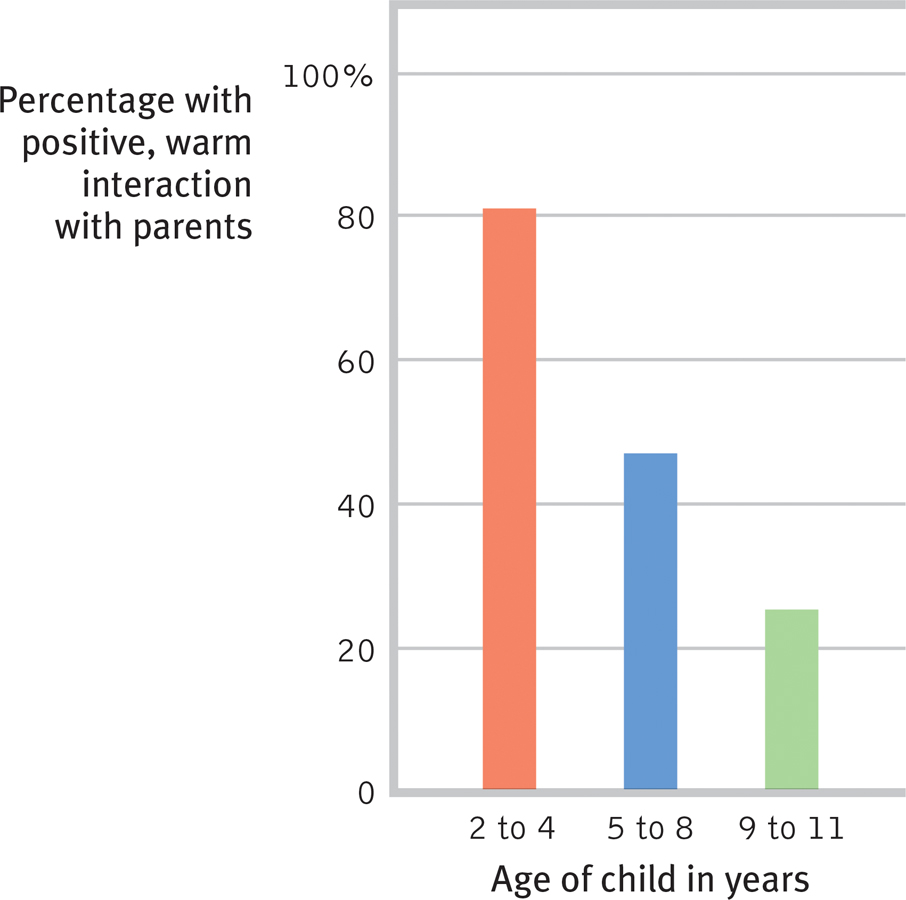
 Figure 5.19
Figure 5.19The changing parent-child relationship In a large national study of Canadian families, interviews revealed that the typically close, warm relationships between parents and preschoolers loosened as children became older. (Data from Statistics Canada, 1999.)

For a minority of parents and their adolescents, differences lead to real splits and great stress (Steinberg & Morris, 2001). But most disagreements are at the level of harmless bickering. With sons, the issues often are behavior problems, such as acting out or hygiene, while for daughters, the issues commonly involve relationships, such as dating and friendships (Schlomer et al., 2011). Most adolescents—6000 of them surveyed in 10 countries, from Australia to Bangladesh to Turkey—have said they like their parents (Offer et al., 1988). “We usually get along but …,” adolescents often reported (Galambos, 1992; Steinberg, 1987).
“I love u guys.”
Emily Keyes’ final text message to her parents before dying in a Colorado school shooting, 2006
211
Positive parent-teen relations and positive peer relations often go hand in hand. High school girls who had the most affectionate relationships with their mothers tended also to enjoy the most intimate friendships with girlfriends (Gold & Yanof, 1985). And teens who felt close to their parents have tended to be healthy and happy and to do well in school (Resnick et al., 1997). Of course, we can state this correlation the other way: Misbehaving teens are more likely to have tense relationships with parents and other adults.
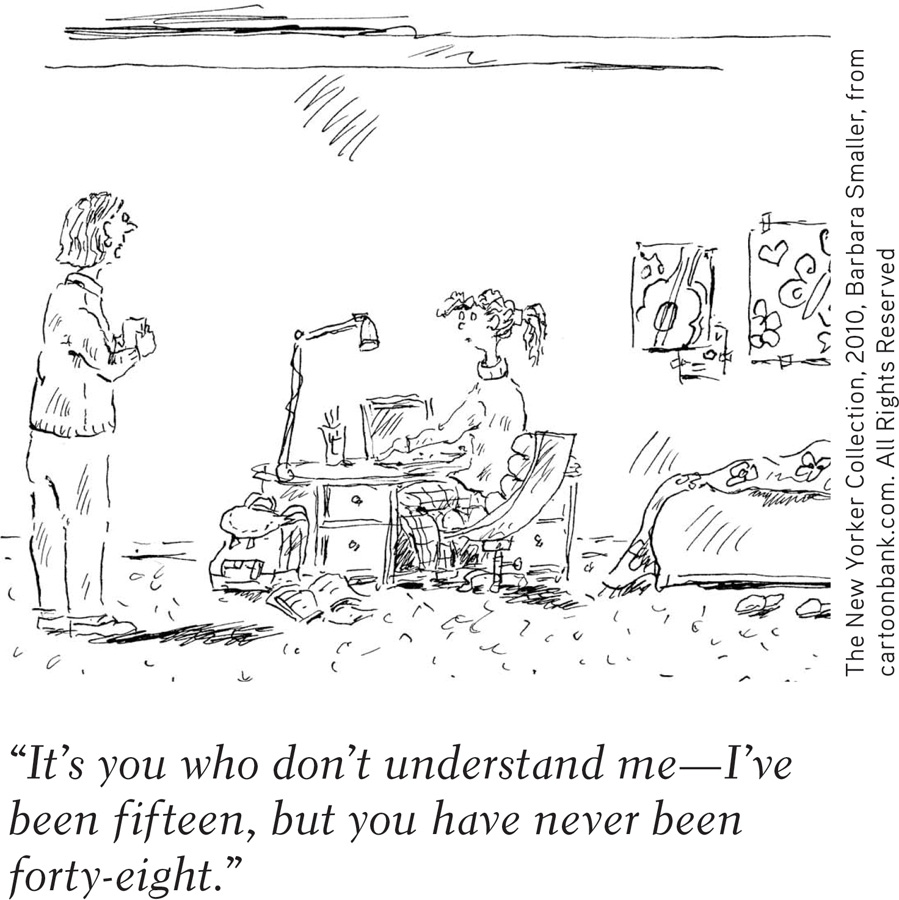
Adolescence is typically a time of diminishing parental influence and growing peer influence. Asked in a survey if they had “ever had a serious talk” with their child about illegal drugs, 85 percent of American parents answered Yes. But if the parents had indeed given this earnest advice, many teens had apparently tuned it out: Only 45 percent could recall such a talk (Morin & Brossard, 1997).
As we noted in Chapter 4, heredity does much of the heavy lifting in forming individual temperament and personality differences, and peer influences do much of the rest. When with peers, teens discount the future and focus more on immediate rewards (O’Brien et al., 2011). Most teens are herd animals. They talk, dress, and act more like their peers than their parents. What their friends are, they often become, and what “everybody’s doing,” they often do.
Part of what everybody’s doing is networking—a lot. Teens rapidly adopt social media. U.S. teens typically send 60 text messages daily and average 300 Facebook friends (Pew, 2012, 2013). Online communication stimulates intimate self-disclosure—both for better (support groups) and for worse (online predators and extremist groups) (Subrahmanyam & Greenfield, 2008; Valkenburg & Peter, 2009; Wilson et al., 2012). Facebook, from a study of all its English-language users, reports this: Among parents and children, 371 days elapse, on average, before they include each other in their circle of self-disclosure (Burke et al., 2013).
Both online and in real life, for those who feel excluded by their peers, the pain is acute. “The social atmosphere in most high schools is poisonously clique-driven and exclusionary,” observed social psychologist Elliot Aronson (2001). Most excluded “students suffer in silence…. A small number act out in violent ways against their classmates.” Those who withdraw are vulnerable to loneliness, low self-esteem, and depression (Steinberg & Morris, 2001). Peer approval matters.
Teens have tended to see their parents as having more influence in other areas—for example, in shaping their religious faith and in thinking about college and career choices (Emerging Trends, 1997). A Gallup Youth Survey revealed that most shared their parents’ political views (Lyons, 2005).
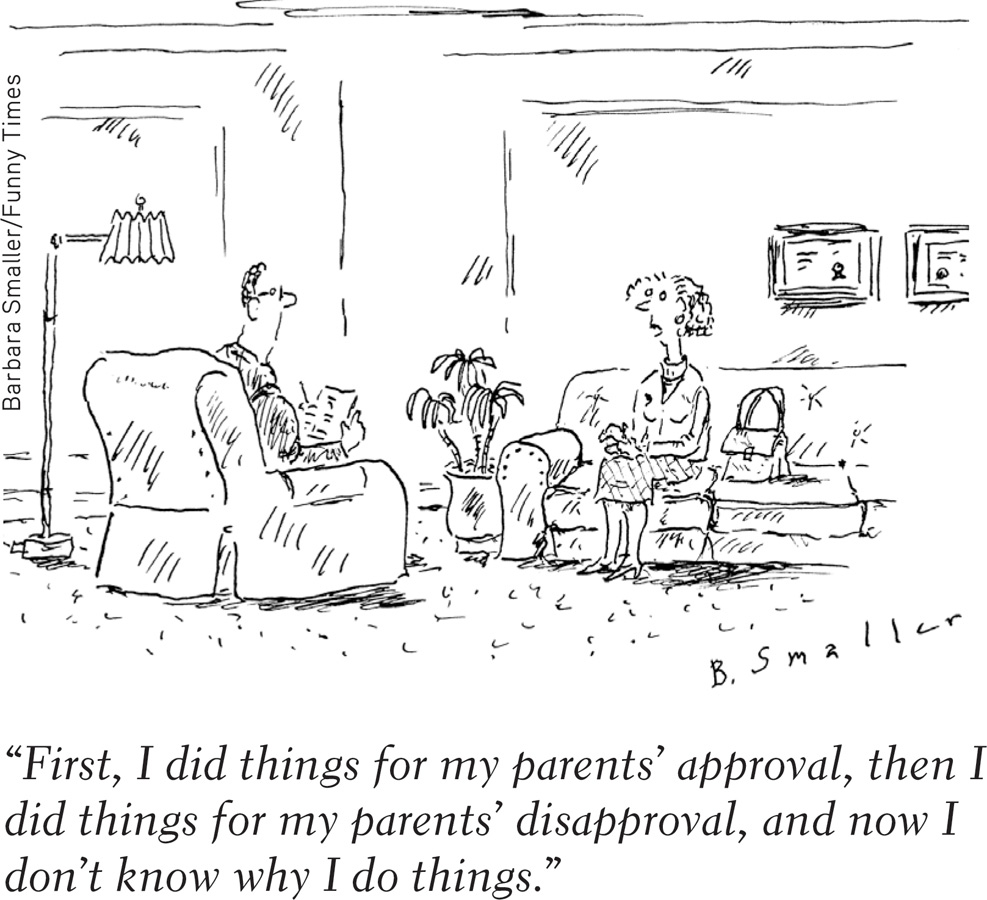
212
Emerging Adulthood

5-16 What is emerging adulthood?
In the Western world, adolescence now roughly corresponds to the teen years. At earlier times, and in other parts of the world today, this slice of life has been much smaller (Baumeister & Tice, 1986). Shortly after sexual maturity, young people would assume adult responsibilities and status. The event might be celebrated with an elaborate initiation—a public rite of passage. The new adult would then work, marry, and have children.
When schooling became compulsory in many Western countries, independence was put on hold until after graduation. From Europe to Australia, adolescents now take more time to establish themselves as adults. In the United States, for example, the average age at first marriage has increased more than 5 years since 1960, to 29 for men, and 27 for women. In 1960, three in four women and two in three men had, by age 30, finished school, left home, become financially independent, married, and had a child. Today, fewer than half of 30-year-old women and one-third of men have met these five milestones (Henig, 2010).

Together, later independence and earlier sexual maturity have widened the once-brief interlude between biological maturity and social independence (FIGURE 5.20). In prosperous communities, the time from 18 to the mid-twenties is an increasingly not-yet-settled phase of life, now often called emerging adulthood (Arnett, 2006, 2007; Reitzle, 2006). No longer adolescents, these emerging adults, having not yet assumed full adult responsibilities and independence, feel “in between.” After high school, those who enter the job market or go to college may be managing their own time and priorities more than ever before. Yet they may be doing so from their parents’ home—unable to afford their own place and perhaps still emotionally dependent as well. Recognizing today’s more gradually emerging adulthood, the U.S. government now allows dependent children up to age 26 to remain on their parents’ health insurance (Cohen, 2010).
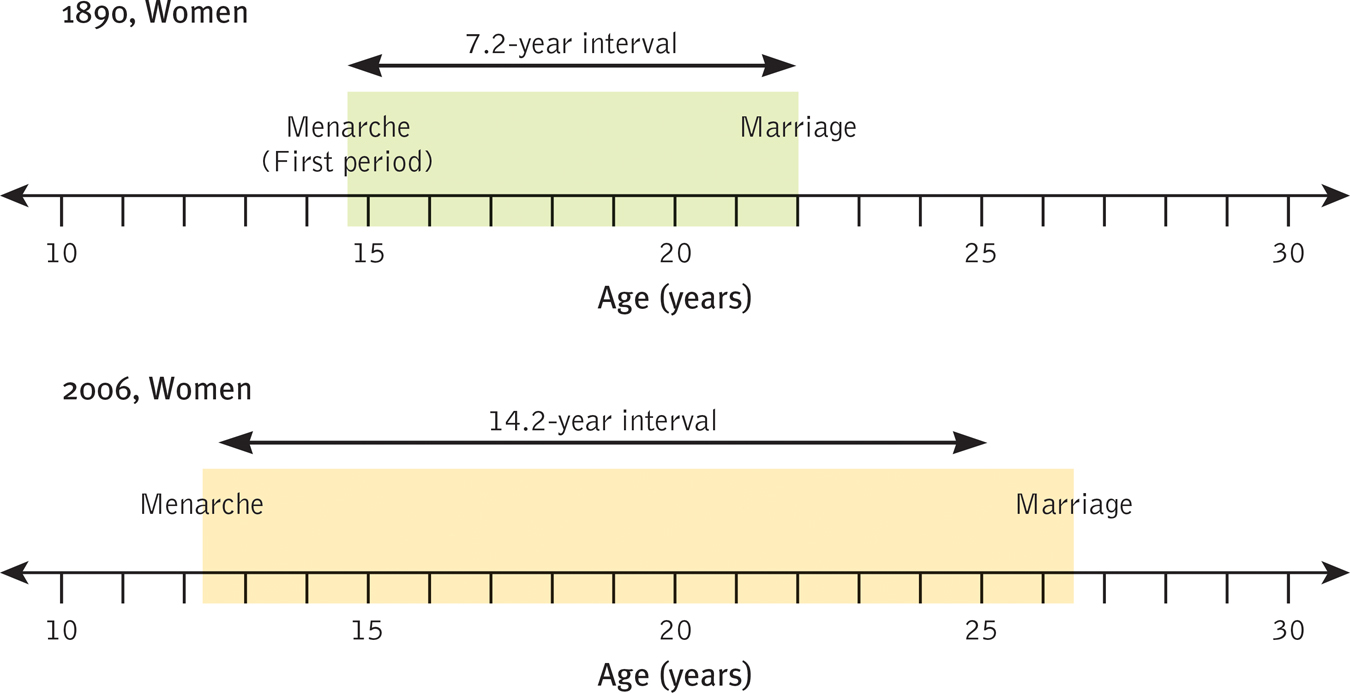
 Figure 5.20
Figure 5.20The transition to adulthood is being stretched from both ends In the 1890s, the average interval between a woman’s first menstrual period and marriage, which typically marked a transition to adulthood, was about 7 years; a century later in industrialized countries it was about 14 years (Finer & Philbin, 2014; Guttmacher, 1994). Although many adults are unmarried, later marriage combines with prolonged education and earlier menarche to help stretch out the transition to adulthood.
emerging adulthood a period from about age 18 to the mid-twenties, when many in Western cultures are no longer adolescents but have not yet achieved full independence as adults.
213
RETRIEVAL PRACTICE
- Match the psychosocial development stage below (1–8) with the issue that Erikson believed we wrestle with at that stage (a–h).
|
1. Infancy 2. Toddlerhood 3. Preschool |
4. Elementary school 5. Adolescence 6. Young adulthood |
7. Middle adulthood 8. Late adulthood |
|
a. Generativity vs. stagnation b. Integrity vs. despair c. Initiative vs. guilt d. Intimacy vs. isolation |
e. Identity vs. role confusion f. Competence vs. inferiority g. Trust vs. mistrust h. Autonomy vs. shame and doubt |
1. g, 2. h, 3. c, 4. f,
5. e, 6. d, 7. a, 8. b
REVIEW: Adolescence

|
REVIEW | Adolescence |
LEARNING OBJECTIVES
RETRIEVAL PRACTICE Take a moment to answer each of these Learning Objective Questions (repeated here from within this section). Then click the 'show answer' button to check your answers. Research suggests that trying to answer these questions on your own will improve your long-term retention (McDaniel et al., 2009).
5-12 How is adolescence defined, and how do physical changes affect developing teens?
Adolescence is the transition period from childhood to adulthood, extending from puberty to social independence. Boys seem to benefit (though with risks) from “early” maturation, girls from “late” maturation. The brain’s frontal lobes mature and myelin growth increases during adolescence and the early twenties, enabling improved judgment, impulse control, and long-term planning.
5-13 How did Piaget, Kohlberg, and later researchers describe adolescent cognitive and moral development?
Piaget theorized that adolescents develop a capacity for formal operations and that this development is the foundation for moral judgment. Lawrence Kohlberg proposed a stage theory of moral reasoning, from a preconventional morality of self-interest, to a conventional morality concerned with upholding laws and social rules, to (in some people) a postconventional morality of universal ethical principles. Other researchers believe that morality lies in moral intuition and moral action as well as thinking. Some critics argue that Kohlberg’s postconventional level represents morality from the perspective of individualist, middle-class people.
5-14 What are the social tasks and challenges of adolescence?
Erikson theorized that each life stage has its own psychosocial task, and that a chief task of adolescence is solidifying one’s sense of self—one’s identity. This often means trying out a number of different roles. Social identity is the part of the self-concept that comes from a person’s group memberships.
5-15 How do parents and peers influence adolescents?
During adolescence, parental influence diminishes and peer influence increases, in part because of the selection effect—the tendency to choose similar others. But adolescents also do adopt their peers’ ways of dressing, acting, and communicating. Parents have more influence in religion, politics, and college and career choices.
5-16 What is emerging adulthood?
The transition from adolescence to adulthood is now taking longer. Emerging adulthood is the period from age 18 to the mid-twenties, when many young people are not yet fully independent. But observers note that this stage is found mostly in today’s Western cultures.
TERMS AND CONCEPTS TO REMEMBER
RETRIEVAL PRACTICE Match each of the terms on the left with its definition on the right. Click on the term first and then click on the matching definition. As you match them correctly they will move to the bottom of the activity.
Question
adolescence puberty identity social identity intimacy emerging adulthood | a period from about age 18 to the mid-twenties, when many in Western cultures are no longer adolescents but have not yet achieved full independence as adults. the period of sexual maturation, during which a person becomes capable of reproducing. in Erikson’s theory, the ability to form close, loving relationships; a primary developmental task in young adulthood. the “we” aspect of our self-concept; the part of our answer to “Who am I?” that comes from our group memberships. our sense of self; according to Erikson, the adolescent’s task is to solidify a sense of self by testing and integrating various roles. the transition period from childhood to adulthood, extending from puberty to independence. |
Use  to create your personalized study plan, which will direct you to the resources that will help you most in
to create your personalized study plan, which will direct you to the resources that will help you most in  .
.